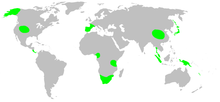Family of spiders
Telemidae, also known as long-legged cave spiders, is a family of small haplogyne spiders. Most are cave dwelling spiders with six eyes, though some do not have any eyes at all. There are about 104 described species in sixteen genera.[1]
Physical features
The legs are long, thin, relatively spineless, and do not have trichobothria. They have three pairs of spinnerets, the longest of which is toward the head. Instead of book lungs, they have two pairs of tracheal spiracles. The elongate abdomen bears a hardened ridge above the pedicel running in a zigzag pattern that is more clearly defined in males than females. The pedipalp on males is oval and bag-like with a thin spermatophore. The female pedipalp does not have a claw.[2]
Genera
As of July 2022[update], the World Spider Catalog accepts the following genera:[1]
- Apneumonella Fage, 1921 — Asia, Africa
- Burmalema Zhao & Li, 2022 — Myanmar
- Cangoderces Harington, 1951 — Cameroon, Ivory Coast, South Africa, DR Congo
- Guhua Zhao & Li, 2017 — Kenya
- Jocquella Baert, 1980 — Papua New Guinea
- Kinku Dupérré & Tapia, 2015 — Ecuador
- Mekonglema Zhao & Li, 2020 — China, Thailand, Laos
- Microlema Zhao & Li, 2022 — Thailand, Vietnam
- Pinelema Wang & Li, 2012 — China, Vietnam
- Seychellia Saaristo, 1978 — Africa
- Siamlema Zhao & Li, 2020 — Thailand
- Sundalema Zhao & Li, 2020 — Thailand, Indonesia
- Telema Simon, 1882 — Asia, Guatemala, Europe
- Telemofila Wunderlich, 1995 — Singapore, Malaysia, New Caledonia, Indonesia
- Usofila Keyserling, 1891 — United States
- Zhuanlema Zhao & Li, 2020 — Laos

